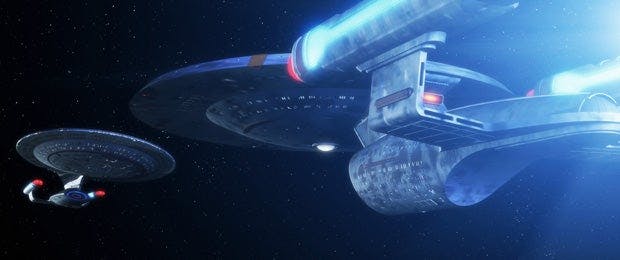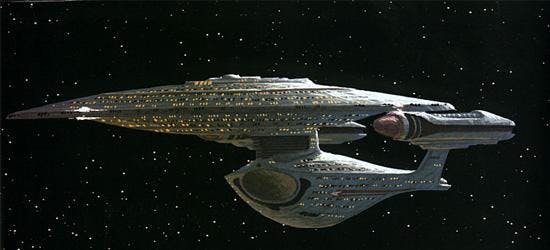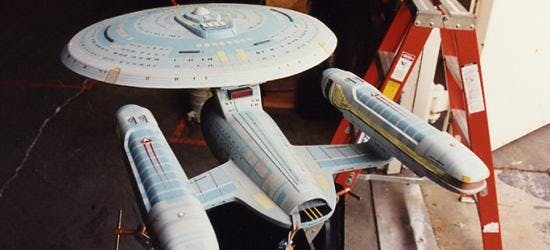Published Feb 26, 2015
FORGOTTEN TREK: Designing The Enterprise-C
FORGOTTEN TREK: Designing The Enterprise-C

The design process for the Enterprise-C, the predecessor to Star Trek: The Next Generation‘s flagship which was to appear in the popular third-season episode “Yesterday’s Enterprise,” began two years before the ship appeared on screen.
When Andrew Probert was designing the Enterprise-D, he prepared a design lineage to establish a continuity between Kirk’s original Enterprise and the new show’s starship which was supposed to be a hundred years older.

Probert assumed that the Enterprise-B was an Excelsior class ship. Even if this wasn’t confirmed until Star Trek Generations, there was a relief model of an Excelsior in the Enterprise-D’s Observation Lounge. Probert reasoned that the “C” would have design elements in common with both ships. “I wanted there to be evidence of the ‘C’ growing from the Excelsior and then the ‘D’ growing from the ‘C,’” he told Star Trek: The Magazine 3, 4 (August 2002). "What I did was I took a side profile of the Excelsior and I took a side profile of the Galaxy class. Then I put them in the same scale one above the other and simply drew lines from one to the other at various important points, whether it was the saucer, the impulse engines, the bridge, the engineering hull, whatever. By doing that I came up with a composite which became the Enterprise-C."
After Probert left the show at the end of the first season, the remaining illustrators weren’t quite sure what the designs that he had prepared were supposed to be for. Rick Sternbach, who took over from Probert, assumed that they were rejected designs for the Enterprise-D, although he noticed the similarities with the Excelsior.
When the Enterprise-C was finally to make its appearance in “Yesterday’s Enterprise,” Sternbach’s thinking went similar to Probert’s. “The logical starting point for this design was an intermediate step between the Excelsior class and Galaxy class," he said. "This little color sketch of Andy’s from the first season looked like it would be great to start with. The nacelles were a bit different. I assumed from the sketch that it had more of a round saucer. It had a very Excelsior-looking neck.”

"I took some of the ideas and some of the design elements of Andy’s that were in the sketch and threw up a top view and a side view in ortho," Sternbach said. "I showed those to the producers and made the case that this would an intermediate step and could very well be the Ambassador class."
Sternbach was a bit more practical than Probert in that his design was less curved. “I remember making the cross section of the engineering hull circular, simply because it would make fabrication go faster,” he recalled.
Even so, the elliptical saucer was rather more difficult to create than a round one like the Excelsior had, Michael Okuda recalled in 2008. “Round is indeed more expensive to build than sharp and square but elliptical can be a lot more expensive than both. This was a big deal for a model that had to be built on a very tight schedule for an episode that was already very expensive.”
Okuda and Sternbach quickly decided to make the Enterprise-C’s saucer circular as well. “Rick will be the first to admit that the resulting design wasn’t as elegant as the original concept,” said the former, “but I think he did a great job of preserving as much as possible of Andy Probert’s vision while keeping the cost low enough that our producers wouldn’t be forced to reuse the Excelsior or the movie Enterprise. And, of course, Greg Jein did his usual brilliant job in building a new starship in record time, on an embarrassingly low budget.”

Because they had precious little time to complete the model, Jein delegated the fabrication of the warp nacelles—which Sternbach had intentionally oversized compared to the Enterprise-D—to David Merriman and the creation of the secondary hull to Ed Miarecki.
Following its introduction in “Yesterday’s Enterprise,” Jein modified the model to appear as different Ambassador class starships in later The Next Generation episodes. The saucer and nacelles were attached at further distance from the engineering hull, resulting in a slightly larger ship.
Nick Ottens is the man behind the Forgotten Trek website. The site bills itself as "the largest resource about the production and behind the scenes of Star Trek." Online since 2002, it features concept art, photographs and interviews, some of which has never been published before.. or until now. Be sure to visit the site at Forgotten Trek and keep an eye on StarTrek.com for future pieces from the site's archive.

